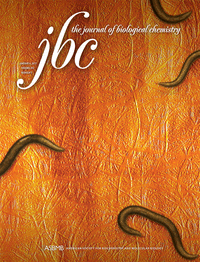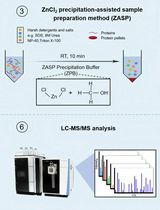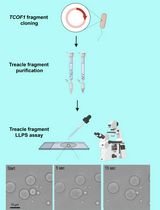- EN - English
- CN - 中文
Streptavidin Bead Pulldown Assay to Determine Protein Homooligomerization
采用链霉亲和素珠Pulldown实验测定蛋白质同源寡聚
发布: 2017年11月20日第7卷第22期 DOI: 10.21769/BioProtoc.2901 浏览次数: 22015
评审: Anonymous reviewer(s)

相关实验方案

适用于 LC–MS/MS 蛋白质组学分析的大体积细胞培养上清分泌组样品制备方法优化
Basil Baby Mattamana [...] Peter Allen Faull
2025年12月20日 923 阅读
Abstract
Pulldown assay is a conventional method to determine protein-protein interactions in vitro. Expressing a protein of interest with two different tags allows testing whether both versions can be captured via one of the two tags as homooligomeric complex. This protocol is based on streptavidin bead capture of a biotinylated protein and co-associated Flag-tagged protein using Streptavidin MagBeads.
Keywords: Pulldown assay (Pulldown 实验)Background
The amyloid precursor protein (APP) can form a homodimer through its large extracellular domain as well as its transmembrane domain, which plays an important role in biological function. The current protocol has been used in characterizing homo-dimerization of the APP transmembrane C-terminal 99 amino acid fragment (C99) (Yan et al., 2017). The basic principle of this assay is shown in Figure 1: The streptavidin-coated MagBeads can trap the biotinylated protein, which can pull down the interaction protein and detected by anti-FLAG antibody.
Figure 1. The principle of MagBeads-based pull-down assay. In this particular protocol, biotinylated Avi-tagged C99 proteins and associated C99-TEV site-rTA-Flag protein were used.
Materials and Reagents
- Pipette tips (VWR)
- 6-well plate (Corning, Costar®, catalog number: 3506 )
- 1.5 ml Eppendorf tube
- 96-well plate (Corning, catalog number: 3595 )
- Cell culture flask (Corning, catalog number: 430639 )
- 96-well OptiPlate (PerkinElmer, catalog number: 6005290 )
- Gel loading pipette tips
- InvitrolonTM PVDF/Filter Paper Sandwich (Thermo Fisher Scientific, InvitrogenTM, catalog number: LC2005 )
- PS1/PS2-deleted HTL cells (PS1/PS2 gene were deleted by CRISPR/Cas9 from HTL cells [Xu et al., 2016])
- Dulbecco’s modified Eagle’s medium (DMEM) (Thermo Fisher Scientific, GibcoTM, catalog number: 11965092 )
- Fetal bovine serum (FBS) (Thermo Fisher Scientific, GibcoTM, catalog number: 26140079 )
- Trypsin 0.25%-EDTA (Thermo Fisher Scientific, GibcoTM, catalog number: 25200056 )
- Opti-MEM (Thermo Fisher Scientific, GibcoTM, catalog number: 31985062 )
- Lipofectamine 2000 Transfection Reagent (Thermo Fisher Scientific, InvitrogenTM, catalog number: 11668019 )
- Streptavidin MagBeads (GenScript, catalog number: L00424 )
- CelLyticTM M (Sigma-Aldrich, catalog number: C2978 )
- Protease inhibitor cocktail (Roche Diagnostics, catalog number: 11836153001 )
- 2x SDS loading buffer (Bio-Rad Laboratories, catalog number: 1610737 )
- β-Mercaptoethanol (Bio-Rad Laboratories, catalog number: 1610710 )
- BoltTM 4-12% Bis-Tris Plus Gels, 15-well (Thermo Fisher Scientific, catalog number: NW04125BOX )
- NovexTM Tris-Glycine Transfer Buffer (25x) (Thermo Fisher Scientific, InvitrogenTM, catalog number: LC3675 )
- Precision plus Protein prestained standard (Bio-Rad Laboratories, catalog number: 1610374 )
- Methanol (EMD Millipore, catalog number: MX0485-5 )
- Seppro® stripping buffer (Sigma-Aldrich, catalog number: S4324 )
- Biotin (Sigma-Aldrich, catalog number: B4501 )
- Sodium hydroxide (NaOH) solution (Fisher Scientific, catalog number: SS255 )
- Sodium phosphate dibasic (Na2HPO4) (Fisher Scientific, catalog number: S374-1 )
- Potassium phosphate monobasic (KH2PO4) (EMD Millipore, catalog number: PX1565-1 )
- Sodium chloride (NaCl) (EMD Millipore, catalog number: SX0420-5 )
- Potassium chloride (KCl) (Fisher Scientific, catalog number: BP366-500 )
- Tris base (Fisher Scientific, catalog number: BP152-5 )
- Glycine (Fisher Scientific, catalog number: BP381-5 )
- Sodium dodecyl sulfate (SDS) (Sigma-Aldrich, catalog number: L3771 )
- Hydrochloric acid (HCl) (EMD Millipore, catalog number: HX0603-75 )
- Tween 20 (EMD Millipore, catalog number: 9480-OP )
- Milk powder (Bio-Rad Laboratories, catalog number: 1706404 )
- Anti-FLAG-peroxidase antibody (Sigma-Aldrich, catalog number: A8592 )
- Anti-beta actin antibody (Abcam, catalog number: ab6276 )
- Anti-mouse IgG, HRP-linked antibody (Cell Signaling Technology, catalog number: 7076S )
- SuperSignal West Pico substrate (Thermo Fisher Scientific, catalog number: 34080 )
Note: This product has been discontinued. - Highly pure water (ddH2O) (produced by PURELAB Ultra system)
- Biotin solution (see Recipes)
- Phosphate buffered saline (PBS buffer) 10x (see Recipes)
- Electrophoresis buffer (see Recipes)
- Tris-buffered saline (TBS buffer) 10x (see Recipes)
- TBST buffer (see Recipes)
- Blocking solution (see Recipes)
- Anti-FLAG antibody solution (see Recipes)
- Anti-beta actin primary antibody solution (see Recipes)
- Anti-mouse IgG secondary antibody solution (see Recipes)
- Substrate solution (see Recipes)
Equipment
- Pipettes
- 37 °C, 5% CO2 incubator (Thermo Fisher Scientific, Thermo ScientificTM, model: FormaTM Series II 3110 Water-Jacketed)
- Cell culture microscope (Nikon Instruments, model: Eclipse TS100 )
- Biosafety cabinet (The Baker, model: SterilGARD® e3 )
- Standard tabletop centrifuge (Eppendorf, model: 5417 R )
- Invitrogen SDS-PAGE running cassette (Thermo Fisher Scientific, catalog number: A25977 )
- Tank blot device (Bio-Rad Laboratories, model: Mini Trans-Blot® Module, catalog number: 1658029FC )
- ChemiDocTM XRS+ Imager System (Bio-Rad Laboratories, model: ChemiDocTM XRS+ )
- Shaker (Fisher Scientific, model: Chemistry Mixer 346 )
- Rocking platform (ARMA LAB, model: Orbital Shaker 100 )
- Magnetic separation rack (Thermo Fisher Scientific, catalog number: 12321D )
Software
- Image Lab 5.2.1 software (http://www.bio-rad.com/en-ch/product/image-lab-software)
Procedure
文章信息
版权信息
© 2017 The Authors; exclusive licensee Bio-protocol LLC.
如何引用
Readers should cite both the Bio-protocol article and the original research article where this protocol was used:
- Xu, T., Yan, Y., Harikumar, K. G., Miller, L. J., Melcher, K. and Xu, H. E. (2017). Streptavidin Bead Pulldown Assay to Determine Protein Homooligomerization. Bio-protocol 7(22): e2901. DOI: 10.21769/BioProtoc.2901.
- Yan, Y., Xu, T. H., Harikumar, K. G., Miller, L. J., Melcher, K. and Xu, H. E. (2017a). Dimerization of the transmembrane domain of amyloid precursor protein is determined by residues around the gamma-secretase cleavage sites. J Biol Chem, 292: 15826-15837.
分类
生物化学 > 蛋白质 > 分离和纯化
分子生物学 > 蛋白质 > 蛋白质-蛋白质相互作用
您对这篇实验方法有问题吗?
在此处发布您的问题,我们将邀请本文作者来回答。同时,我们会将您的问题发布到Bio-protocol Exchange,以便寻求社区成员的帮助。
Share
Bluesky
X
Copy link













